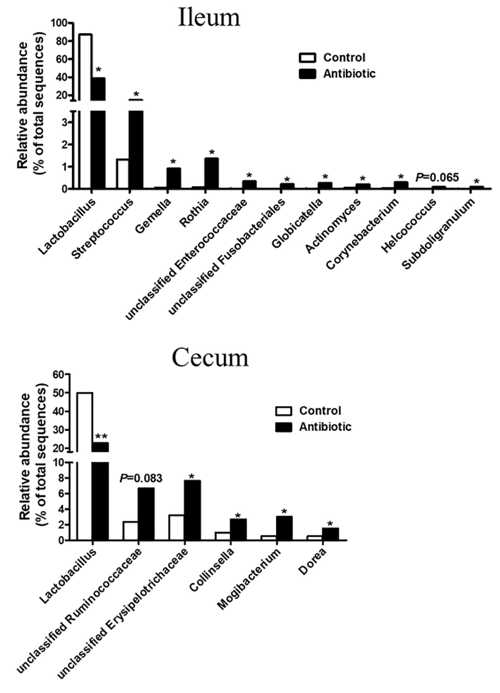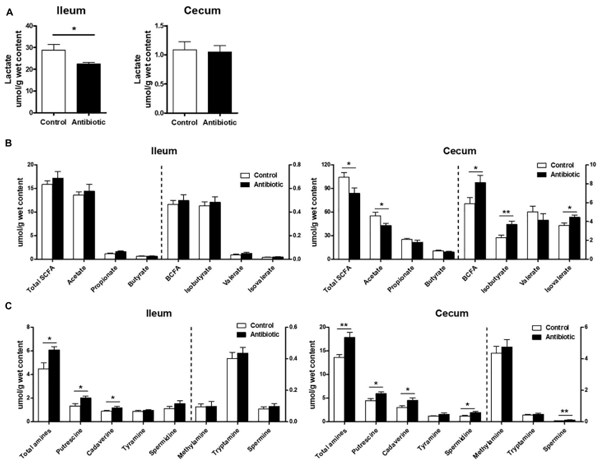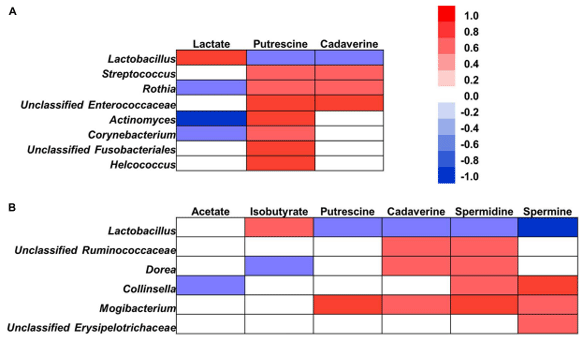Marked Response in Microbial Community and Metabolism in the Ileum and Cecum of Suckling Piglets After Early Antibiotics Exposure
Author details:
In modern swine husbandry systems, antibiotics have been used as growth promoters for piglets during suckling or weaning period. However, while early colonization of intestinal microbiota has been regarded crucial for the host’s later life performance and well-being, little is known about the impact of antibiotics on intestinal microbiota in suckling piglets. The present study aimed to investigate the effects of early antibiotics exposure on gut microbiota and microbial metabolism of suckling piglets. Sixteen litters of suckling piglets were fed a creep feed diet with (Antibiotic) or without (Control) antibiotics from postnatal days 7–23 (n = 8). The ileal and cecal digesta were obtained for microbial composition and microbial metabolites analysis. The results showed that the antibiotics significantly altered the bacterial community composition by decreasing (P < 0.05) the diversity and richness in the ileum. The antibiotics significantly reduced the abundance of Lactobacillus in both the ileum and cecum, increased the abundance of Streptococcus, unclassified Enterococcaceae, unclassified Fusobacteriales, and Corynebacterium in the ileum, and the abundance of unclassified Ruminococcaceae and unclassified Erysipelotrichaceae in the cecum. The antibiotics decreased (P < 0.05) ileal lactate concentration and cecal concentration of total short-chain fatty acids (SCFAs). But the antibiotics enhanced protein fermentation (P < 0.05) in the ileum and cecum, as ileal concentrations of putrescine and cadaverine, and cecal concentrations of isobutyrate, isovalerate, putrescine, cadaverine, spermine, and spermidine were significantly increased (P < 0.05). These results indicated that early antibiotics exposure significantly altered the microbial composition of suckling piglets toward a vulnerable and unhealthy gut environment. The findings provide a new insight on the antibiotics impact on neonates and may provide new framework for designing alternatives to the antibiotics toward a healthy practice for suckling piglets.
Keywords: ileum, cecum, early antibiotics exposure, microbial community, microbial metabolites, suckling piglets.
Introduction
Materials and methods
Ethics Statement
Animal, Diet and Experimental Design
Chemical Composition Analysis
DNA Extraction and Preparation of Amplicons for High-Throughput Pyrosequencing
Bioinformatics Analyses
Statistical Analysis
Results
Growth Performance
Effects of Early Antibiotics Exposure on Ileal and Cecal Bacterial Community Structure Revealed by Pyrosequencing







Effects of Early Antibiotics Exposure on Fermentation Metabolites in Ileum and Cecum Digesta
Correlation Between Bacterial Fermentation Productions With Bacteria
Discussion
Early Antibiotics Exposure Altered the Microbial Community Structure of the Suckling Piglets, With More Evident Effect in the Ileum Than in the Cecum
Early Antibiotics Exposure Markedly Reduced Lactate Concentration in the Ileum of the Suckling Piglets
Early Antibiotics Exposure Markedly Reduced SCFAs Concentrations in the Cecum of the Suckling Piglets
Early Antibiotics Exposure Markedly Increased Amines Concentrations in the Ileum and Cecum of the Suckling Piglets
Conclusion
Allen, H. K., Looft, T., Bayles, D. O., Humphrey, S., Levine, U. Y., Alt, D., et al. (2011). Antibiotics in feed induce prophages in swine fecal microbiomes. MBio 2:e00260-11. doi: 10.1128/mBio.00260-11
Altschul, S. F., Gish, W., Miller, W., Myers, E. W., and Lipman, D. J. (1990). Basic local alignment search tool. J. Mol. Biol. 215, 403–410. doi: 10.1016/S0022- 2836(05)80360-2
Arnal, M.-E., Zhang, J., Messori, S., Bosi, P., Smidt, H., and Lallès, J.-P. (2014). Early changes in microbial colonization selectively modulate intestinal enzymes, but not inducible heat shock proteins in young adult swine. PLoS One 9:e87967. doi: 10.1371/journal.pone.0087967
Benjamini, Y., and Hochberg, Y. (2000). On the adaptive control of the false discovery rate in multiple testing with independent statistics. J. Educ. Behav. Stat. 25, 60–83. doi: 10.3102/10769986025001060
Bhandari, S., Xu, B., Nyachoti, C., Giesting, D., and Krause, D. (2008). Evaluation of alternatives to antibiotics using an Escherichia coli K88+ model of piglet diarrhea: effects on gut microbial ecology. J. Anim. Sci. 86, 836–847. doi: 10.2527/jas.2006-822
Bian, G. R., Ma, S. Q., Zhu, Z. G., Su, Y., Zoetendal, E. G., Mackie, R., et al. (2016). Age, introduction of solid feed and weaning are more important determinants of gut bacterial succession in piglets than breed and nursing mother as revealed by a reciprocal cross-fostering model. Environ. Microbiol. 18, 1566–1577. doi: 10.1111/1462-2920.13272
Blachier, F., Mariotti, F., Huneau, J.-F., and Tomé, D. (2007). Effects of amino acidderived luminal metabolites on the colonic epithelium and physiopathological consequences. Amino Acids 33, 547–562. doi: 10.1007/s00726-006-0477-9
Boleij, A., and Tjalsma, H. (2013). The itinerary of Streptococcus gallolyticus infection in patients with colonic malignant disease. Lancet Infect. Dis. 13, 719–724. doi: 10.1016/S1473-3099(13)70107-5
Campbell, B. J., Polson, S. W., Hanson, T. E., Mack, M. C., and Schuur, E. A. G. (2010). The effect of nutrient deposition on bacterial communities in Arctic tundra soil. Environ. Microbiol. 12, 1842–1854. doi: 10.1111/j.1462-2920.2010. 02189.x
Caporaso, J. G., Lauber, C. L., Walters, W. A., Berglyons, D., Huntley, J., Fierer, N., et al. (2012). Ultra-high-throughput microbial community analysis on the Illumina HiSeq and MiSeq platforms. ISME J. 6, 1621–1624. doi: 10.1038/ismej. 2012.8
Chaney, A. L., and Marbach, E. P. (1962). Modified reagents for determination of urea and ammonia. Clin. Chem. 8, 130–132.
Cho, I., Yamanishi, S., Cox, L., Methé, B. A., Zavadil, J., Li, K., et al. (2012). Antibiotics in early life alter the murine colonic microbiome and adiposity. Nature 488, 621–626. doi: 10.1038/nature11400
Conroy, M. E., Shi, H. N., and Walker, W. A. (2009). The long-term health effects of neonatal microbial flora. Curr. Opin. Allergy Clin. Immunol. 9, 197–201. doi: 10.1097/ACI.0b013e32832b3f1d
Davila, A.-M., Blachier, F., Gotteland, M., Andriamihaja, M., Benetti, P.-H., Sanz, Y., et al. (2013). Intestinal luminal nitrogen metabolism: role of the gut microbiota and consequences for the host. Pharmacol. Res. 68, 95–107. doi: 10.1016/j.phrs.2013.01.003
Edgar, R. C. (2010). Search and clustering orders of magnitude faster than BLAST. Bioinformatics 26, 2460–2461. doi: 10.1093/bioinformatics/btq461
Gargallo, J., and Zimmerman, D. R. (1980). Effects of dietary cellulose and neomycin on function of the cecum of pigs. J. Anim. Sci. 51, 121–126. doi: 10.2527/jas1980.511121x
Gonzalez-Silva, B. M., Rønning, A. J., Andreassen, I. K., Bakke, I., Cervantes, F. J., Østgaard, K., et al. (2017). Changes in the microbial community of an anammox consortium during adaptation to marine conditions revealed by 454 pyrosequencing. Appl. Microbiol. Biotechnol. 101, 5149–5162. doi: 10.1007/ s00253-017-8160-5
Goytia, M., and Shafer, W. M. (2010). Polyamines can increase resistance of Neisseria gonorrhoeae to mediators of the innate human host defense. Infect. Immun. 78, 3187–3195. doi: 10.1128/IAI.01301-09
Hamnes, W., Weiss, N., and Holzapfel, W. (1992). “The genera Lactobacillus and Carnobacterium,” in The Prokaryotes A Handbook on the Biology of Bacteria: Ecophysiology and Isolation, Identification, Applications, Vol. 2, eds A. Balows, H. G. Truper, M. Dworkin, W. Harder, and K.-H. Schleifer (New York, NY: Springer-Verlag), 1536–1594.
Hansen, C. H. F., Nielsen, D. S., Kverka, M., Zakostelska, Z., Klimesova, K., Hudcovic, T., et al. (2013). Patterns of early gut colonization shape future immune responses of the host. PLoS One 7:e34043. doi: 10.1371/journal.pone. 0034043
Holmes, E., Li, J. V., Athanasiou, T., Ashrafian, H., and Nicholson, J. K. (2011). Understanding the role of gut microbiome–host metabolic signal disruption in health and disease. Trends Microbiol. 19, 349–359. doi: 10.1016/j.tim.2011. 05.006
Hooper, L. V., Littman, D. R., and Macpherson, A. J. (2012). Interactions between the microbiota and the immune system. Science 336, 1268–1273. doi: 10.1126/ science.1223490
Huda-Faujan, N., Abdulamir, A. S., Fatimah, A. B., Anas, O. M., Shuhaimi, M., Yazid, A. M., et al. (2010). The impact of the level of the intestinal short chain fatty acids in inflammatory bowel disease patients versus healthy subjects. Open Biochem. J. 4, 53–58. doi: 10.2174/1874091X01004010053
Konstantinov, S. R., Awati, A. A., Williams, B. A., Miller, B. G., Jones, P., Stokes, C. R., et al. (2006). Post-natal development of the porcine microbiota composition and activities. Environ. Microbiol. 8, 1191–1199. doi: 10.1111/j. 1462-2920.2006.01009.x
Lallès, J. P., Bosi, P., Smidt, H., and Stokes, C. R. (2007). Nutritional management of gut health in pigs around weaning. Proc. Nutr. Soc. 66, 260–268. doi: 10.1017/ s0029665107005484
Lim, Y. W., Schmieder, R., Haynes, M., Furlan, M., Matthews, T. D., Whiteson, K., et al. (2013). Mechanistic model of Rothia mucilaginosa adaptation toward persistence in the CF lung, based on a genome reconstructed from metagenomic data. PLoS One 8:e64285. doi: 10.1371/journal.pone.0064285
Looft, T., Allen, H. K., Cantarel, B. L., Levine, U. Y., Bayles, D. O., Alt, D. P., et al. (2014). Bacteria, phages and pigs: the effects of in-feed antibiotics on the microbiome at different gut locations. ISME J. 8, 1566–1576. doi: 10.1038/ismej. 2014.12
Looft, T., Johnson, T. A., Allen, H. K., Bayles, D. O., Alt, D. P., Stedtfeld, R. D., et al. (2012). In-feed antibiotic effects on the swine intestinal microbiome. Proc. Natl. Acad. Sci. U.S.A. 109, 1691–1696. doi: 10.1073/pnas.1120238109
Low, A. G., and Zebrowska, T. (1989). “Digestion in pig”, in Protein Metabolism in Farm Animals Evaluation, Digestion, Absorption and Metabolism, eds H.-D. Bock, B. O. Eggum, A. G. Low, O. Simon, and T. Zebrowska (Oxford: Oxford University Press), 53
Lun, Z. R., Wang, Q. P., Chen, X. G., Li, A. X., and Zhu, X. Q. (2007). Streptococcus suis: an emerging zoonotic pathogen. Lancet Infect. Dis. 7, 201–209. doi: 10.1016/S1473-3099(07)70001-4
Mao, S. Y., Zhang, M. L., Liu, J. H., and Zhu, W. Y. (2015). Characterising the bacterial microbiota across the gastrointestinal tracts of dairy cattle: membership and potential function. Sci. Rep. 5:16116. doi: 10.1038/srep16116
Mayeur, C., Gratadoux, J.-J., Bridonneau, C., Chegdani, F., Larroque, B., Kapel, N., et al. (2013). Faecal D/L lactate ratio is a metabolic signature of microbiota imbalance in patients with short bowel syndrome. PLoS One 8:e54335. doi: 10.1371/journal.pone.0054335
Mu, C. L., Yang, Y. X., Luo, Z., Guan, L. L., and Zhu, W. Y. (2016). The colonic microbiome and epithelial transcriptome are altered in rats fed a high-protein diet compared with a normal-protein diet. J. Nutr. 146, 474–483. doi: 10.3945/ jn.115.223990
Mu, C. L., Yang, Y. X., Su, Y., Zoetendal, E. G., and Zhu, W. Y. (2017a). Differences in microbiota membership along the gastrointestinal tract of piglets and their differential alterations following an early-life antibiotic intervention. Front. Microbiol. 8:797. doi: 10.3389/fmicb.2017.00797
Mu, C. L., Yang, Y. X., Yu, K. F., Yu, M., Zhang, C. J., Su, Y., et al. (2017b). Alteration of metabolomic markers of amino-acid metabolism in piglets with in-feed antibiotics. Amino Acids 49, 771–781. doi: 10.1007/s00726-017- 2379-4
Nicholson, J. K., Holmes, E., and Wilson, I. D. (2005). Gut microorganisms, mammalian metabolism and personalized health care. Nat. Rev. Microbiol. 3, 431–438. doi: 10.1038/nrmicro1152
Pereira, F. C., and Berry, D. (2017). Microbial nutrient niches in the gut. Environ. Microbiol. 19, 1366–1378. doi: 10.1111/1462-2920.13659
Pham, V. T., Lacroix, C., Braegger, C. P., and Chassard, C. (2016). Early colonization of functional groups of microbes in the infant gut. Environ. Microbiol. 18, 2246–2258. doi: 10.1111/1462-2920.13316
Quast, C., Pruesse, E., Yilmaz, P., Gerken, J., Schweer, T., Yarza, P., et al. (2013). The SILVA ribosomal RNA gene database project: improved data processing and web-based tools. Nucleic Acids Res. 41, 590–596. doi: 10.1093/nar/gks 1219
Rist, V., Weiss, E., Eklund, M., and Mosenthin, R. (2013). Impact of dietary protein on microbiota composition and activity in the gastrointestinal tract of piglets in relation to gut health: a review. Animal 7, 1067–1078. doi: 10.1017/ s1751731113000062
Romick-Rosendale, L. E., Goodpaster, A. M., Hanwright, P. J., Patel, N. B., Wheeler, E. T., Chona, D. L., et al. (2009). NMR-based metabonomics analysis of mouse urine and fecal extracts following oral treatment with the broad-spectrum antibiotic enrofloxacin (Baytril). Magn. Reson. Chem. 47(Suppl. 1), S36–S46. doi: 10.1002/mrc.2511
Saavedra, J. M., and Dattilo, A. M. (2012). Early development of intestinal microbiota: implications for future health. Gastroenterol. Clin. North Am. 41, 717–731. doi: 10.1016/j.gtc.2012.08.001
Schloss, P. D., Westcott, S. L., Ryabin, T., Hall, J. R., Hartmann, M., Hollister, E. B., et al. (2009). Introducing mothur: open-source, platform-independent, community-supported software for describing and comparing microbial communities. Appl. Environ. Microbiol. 75, 7537–7541. doi: 10.1128/AEM. 01541-09
Schokker, D., Zhang, J., Zhang, L. L., Vastenhouw, S. A., Heilig, H. G., Smidt, H., et al. (2014). Early-life environmental variation affects intestinal microbiota and immune development in new-born piglets. PLoS One 9:e100040. doi: 10.1371/ journal.pone.0100040
Schumann, A., Nutten, S., Donnicola, D., Comelli, E. M., Mansourian, R., Cherbut, C., et al. (2005). Neonatal antibiotic treatment alters gastrointestinal tract developmental gene expression and intestinal barrier transcriptome. Physiol. Genomics 23, 235–245. doi: 10.1152/physiolgenomics.00057. 2005
Simon, K., Verwoolde, M. B., Zhang, J., Smidt, H., Reilingh, G. D. V., Kemp, B., et al. (2016). Long-term effects of early life microbiota disturbance on adaptive immunity in laying hens. Poult. Sci. 95, 1543–1554. doi: 10.3382/ps/ pew088
Su, Y., Yao, W., Perez-Gutierrez, O. N., Smidt, H., and Zhu, W. Y. (2008). Changes in abundance of Lactobacillus spp. and Streptococcus suis in the stomach, jejunum and ileum of piglets after weaning. FEMS Microbiol. Ecol. 66, 546–555. doi: 10.1111/j.1574-6941.2008.00529.x
Suiryanrayna, M. V., and Ramana, J. V. (2015). A review of the effects of dietary organic acids fed to swine. J. Anim. Sci. Biotechnol. 6:45. doi: 10.1186/s40104- 015-0042-z
Takahashi, N., and Yamada, T. (1999). Glucose and lactate metabolism by Actinomyces naeslundii. Crit. Rev. Oral Biol. Med. 10, 487–503. doi: 10.1177/ 10454411990100040501
Tsiloyiannis, V. K., Kyriakis, S. C., Vlemmas, J., and Sarris, K. (2001). The effect of organic acids on the control of porcine post-weaning diarrhoea. Res. Vet. Sci. 70, 287–293. doi: 10.1053/rvsc.2001.0476
Yang, Y. X., Mu, C. L., Zhang, J. F., and Zhu, W. Y. (2014). Determination of biogenic amines in digesta by high performance liquid chromatography with precolumn dansylation. Anal. Lett. 47, 1290–1298. doi: 10.1080/00032719.2013. 871550
Yano, J. M., Yu, K., Donaldson, G. P., Shastri, G. G., Ann, P., and Ma, L. (2015). Indigenous bacteria from the gut microbiota regulate host serotonin biosynthesis. Cell 161, 264–276. doi: 10.1016/j.cell.2015.02.047
Yu, K. F., Mu, C. L., Yang, Y. X., Su, Y., and Zhu, W. Y. (2017). Segmentspecific responses of intestinal epithelium transcriptome to in-feed antibiotics in pigs. Physiol. Genomics 49, 582–591. doi: 10.1125/physiolgenomics.00020. 2017
Yu, M., Mu, C. L., Yang, Y. X., Zhang, C. J., Su, Y., Huang, Z., et al. (2017a). Increases in circulating amino acids with in-feed antibiotics correlated with gene expression of intestinal amino acid transporters in piglets. Amino Acids 49, 1587–1599. doi: 10.1007/s00726-017-2451-0
Yu, M., Zhang, C. J., Yang, Y. X., Mu, C. L., Su, Y., Yu, K. F., et al. (2017b). Longterm effects of early antibiotic intervention on blood parameters, apparent nutrient digestibility, and fecal microbial fermentation profile in pigs with different dietary protein levels. J. Anim. Sci. Biotechnol. 8:60. doi: 10.1186/ s40104-017-0192-2
Zhang, L. L., Mu, C. L., He, X. Y., Su, Y., Mao, S. Y., Zhang, J., et al. (2016). Effects of dietary fibre source on microbiota composition in the large intestine of suckling piglets. FEMS Microbiol. Lett. 363:fnw138. doi: 10.1093/femsle/ fnw138
Zoetendal, E. G., Akkermans, A. D. L., and Vos, W. M. D. (1998). Temperature gradient gel electrophoresis analysis of 16S rRNA from human fecal samples reveals stable and host-specific communities of active bacteria. Appl. Environ. Microbiol. 64, 3854–3859.






.jpg&w=3840&q=75)